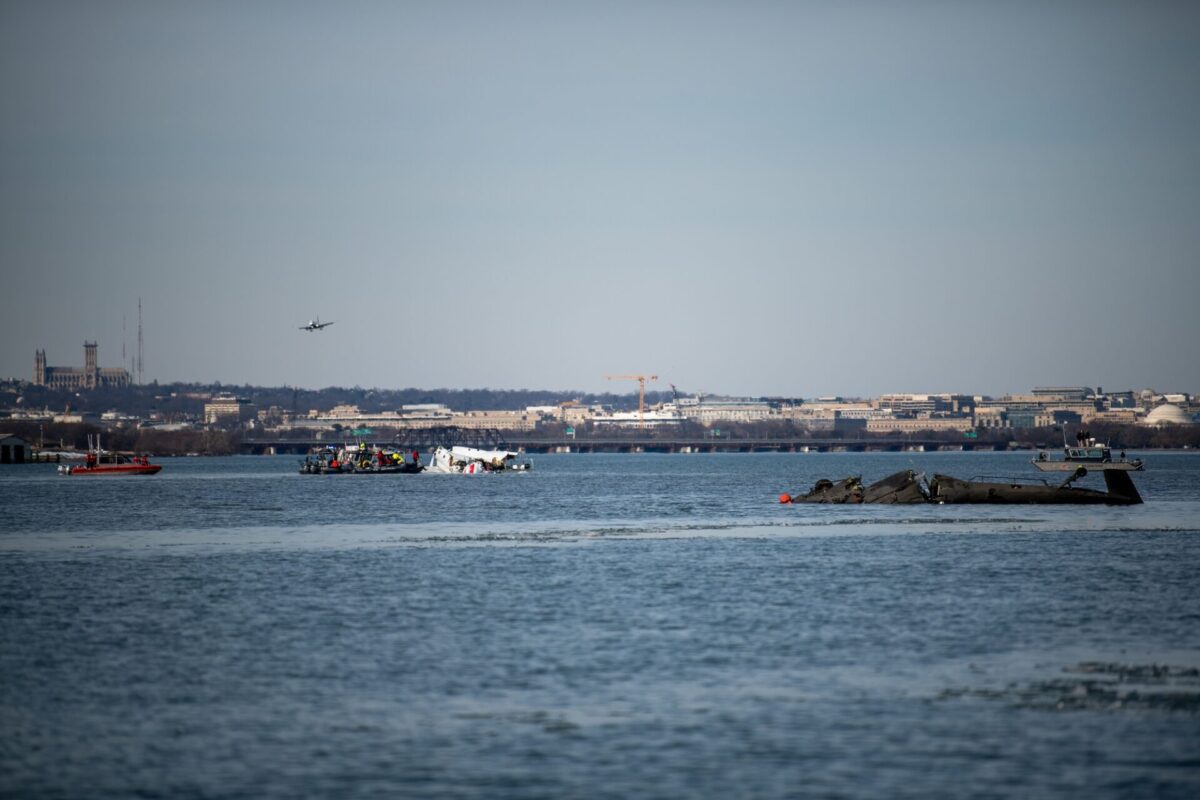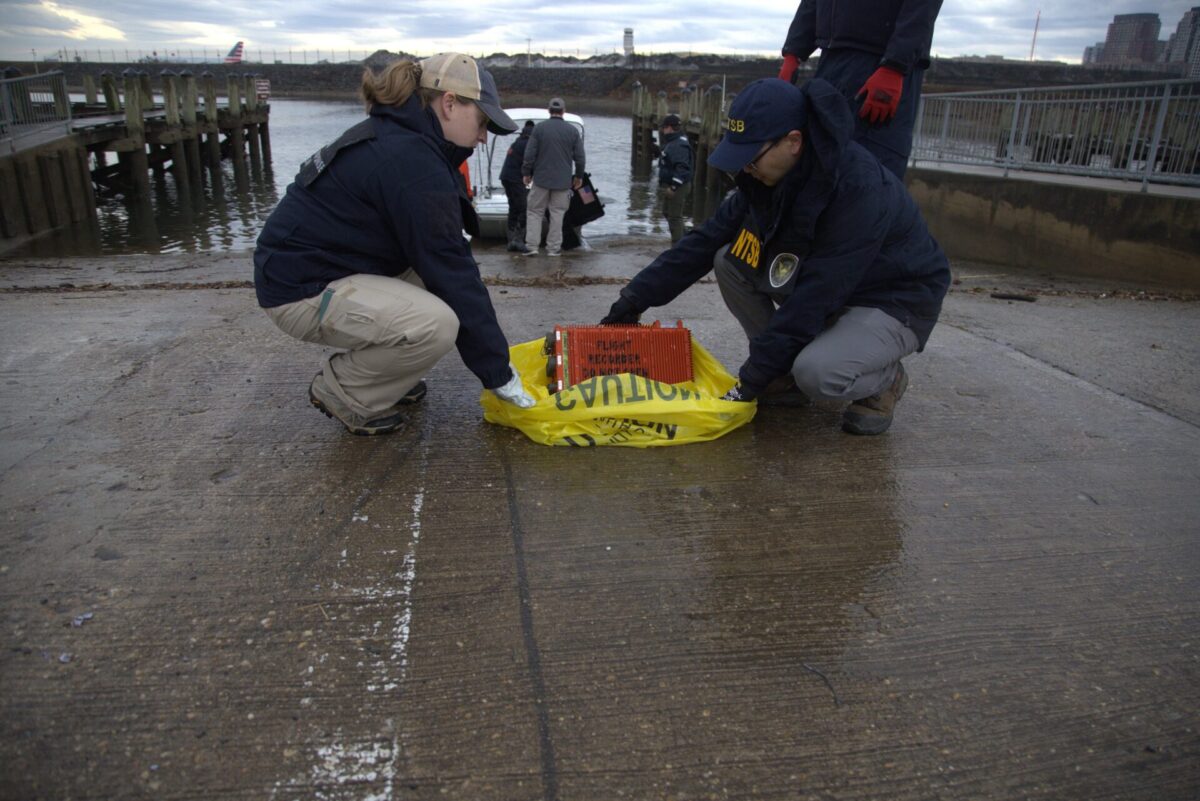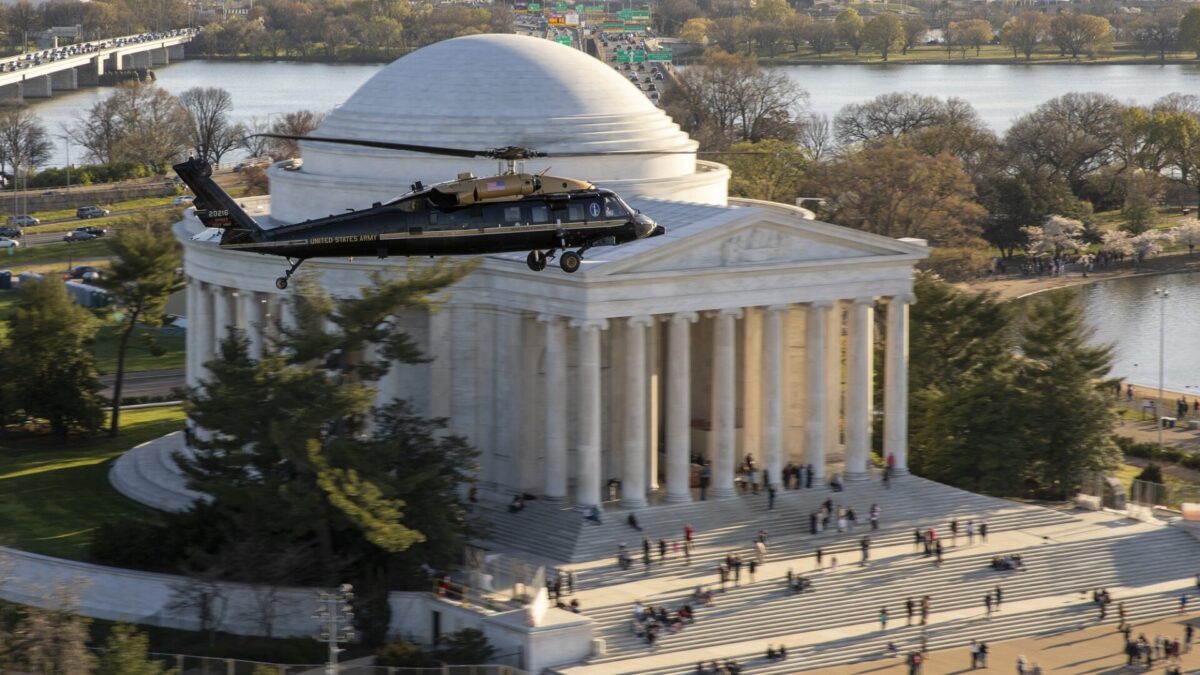NTSB recovers CRJ700 wreckage, investigation progresses
The NTSB and the US Navy Supervisor of Salvage have recovered the aft fuselage, right engine, and right pylon of the Bombardier CRJ700. FBI dive teams are assisting in recovering smaller pieces of wreckage.
As part of the investigation, the NTSB team has obtained the training and flight logs for both flight crews, along with the maintenance records for both aircraft. A team assigned to human performance is analyzing the activities of the crews leading up to the incident, while the Air Traffic Control (ATC) group has completed interviews with all five staff members who were on duty in the tower at the time of the collision.
Investigators are currently working to synchronize data from the flight data recorders and cockpit voice recorders of both aircraft, along with ATC communications and radar scope data to establish a precise timeline of events. However, the Black Hawk’s flight data recorder lacked timestamps, so investigators must manually reconstruct the timeline. This process will require additional time for validation.
55 victims identified, aircraft wreckage recovery to begin
On February 2, 2025, the unified command overseeing the search and recovery operations, which includes the Washington DC Fire and Emergency Medical Services, the US Army Corps of Engineers, and the US Coast Guard, provided an update on the ongoing efforts.
During a media briefing, Washington DC fire chief John Donnelly confirmed that 55 of the 67 victims had been recovered and positively identified.
The recovery of the aircraft wreckage is set to begin on February 3, 2025, with the initial focus on the recovery of the regional jet, a process expected to take three days. Afterward, efforts will shift to the Black Hawk helicopter. All debris is anticipated to be cleared by February 12, 2025.

NTSB briefing: New details on flight data, helicopter recorder, and ATC staffing
On February 1, 2025, the NTSB provided further updates on data recovered from the CRJ’s flight data recorder (FDR), the condition of the H-60 helicopter’s recorder, and the status of air traffic controllers in the DCA tower at the time of the crash.
According to the FDR, the CRJ was at 325 feet ± 25 feet, based on ADS-B and FDR data, while the altitude displayed on air traffic control’s radar scope showed 200 feet. However, this radar data has lower fidelity, and the NTSB hopes to verify the altitude further. The FDR has been fully downloaded, containing approximately 400 parameters of flight data.
Investigators have also retrieved and analyzed the cockpit voice recorder (CVR), which details the sequence of events leading up to the collision. At 20:45:27, the CRJ’s autopilot was disengaged, and at 20:46:01, ATC alerted PAT25 about the CRJ south of Wilson Bridge. The CRJ’s 1000-foot and 500-foot callouts occurred at 20:46:29 and 20:47:29, respectively. At 20:47:39, ATC asked PAT25 if they had the CRJ in sight, just before a “TRAFFIC TRAFFIC” aural alert sounded at 20:47:40. DCA Tower then instructed PAT25 to pass behind the CRJ at 20:47:42. Sixteen seconds later, at 20:47:58, the CRJ crew reacted verbally as the aircraft began increasing pitch, followed by sounds of impact at 20:47:59.
Meanwhile, the H-60 helicopter’s recorder shows evidence of water intrusion, and the NTSB is in the process of drying the recording before attempting data retrieval, which they hope to complete by February 2, 2025.
“We do not know at this time if the night-vision goggles were actually being worn, nor what the setting may be,” NTSB board member Todd commented. “Further investigation should be able to let us know if that occurred and what factor it may play in the overall accident.”
Regarding air traffic control staffing, there were five controllers in the DCA tower at the time of the crash: one local controller managing both fixed-wing and helicopter traffic, one ground controller, one local assistant controller, one supervisor, and one supervisor in training.
The investigation remains ongoing as officials continue analyzing data and verifying key details.

FAA report: ATC staffing was “not normal” at time of crash
An initial report from the Federal Aviation Administration, cited by US media, indicates that staffing levels in the airport control tower were insufficient at the time of the incident.
“The position configuration was not normal for the time of day and volume of traffic,” the preliminary report stated.
According to the leaked report, only one air traffic controller was managing both helicopter and airliner traffic, instead of the usual two.
NTSB recovers black boxes from CRJ700 involved in mid-air collision
NTSB investigators have recovered the cockpit voice recorder and flight data recorder from the Bombardier CRJ700 involved in the mid-air collision at DCA. The recorders have been sent to NTSB laboratories for analysis.
NTSB board member and investigation spokesperson Todd Imman confirmed that the Black Hawk helicopter involved in the incident was also equipped with recording devices.
“These will be analyzed either by the Department of Defense or by us. We have a strong working relationship with them and have already reached an agreement to proceed. I’m confident in the process moving forward.”
NTSB investigators recovered the cockpit voice recorder and flight data recorder from the Bombardier CRJ700 airplane involved in yesterday’s mid-air collision at DCA. The recorders are at the NTSB labs for evaluation. pic.twitter.com/IHypR0Jh76
— NTSB Newsroom (@NTSB_Newsroom) January 31, 2025
Defense Secretary: Helicopter crew was “fairly experienced”
US Defense Secretary Pete Hegseth stated that the helicopter was operated by a “fairly experienced crew” of three soldiers, all wearing night-vision goggles during an annual training flight. Flights from the US Army 12th Aviation Battalion involved in the crash have been grounded while training exercises in the region are reassessed.
Wreckage recovery to begin
The Washington D.C. Fire and EMS Department reported that the investigation and recovery efforts remain ongoing, with divers having searched all accessible areas.
“Tomorrow, divers will work with the NTSB to conduct additional searches to locate aircraft components, support the investigation, and begin salvage operations. Overnight, boats will remain on scene for security and surface searches, coordinated with local, state, and federal regional partners.”
“Do I think this was preventable? Absolutely.”
The newly appointed US Secretary of Transportation, Sean Duffy, was asked about the nature of communication between the helicopter and the tower, the plane and the tower, and between the helicopter and the plane.
“I can confirm that communication did take place. It followed standard procedure, and there was no breakdown in communication between the military helicopter and the American airline flight, if that is your question. The aircraft and the tower maintained communication throughout.“
When asked whether the flight was aware of the helicopter in the area, Duffy stated, “I would say the helicopter was aware that there was a plane.”
Reporters also referenced the President’s remarks that the incident could have been prevented and that air traffic control may not have communicated with the helicopter to provide instructions.
Duffy replied, “We’re going to wait for all the information to come in from this vantage point. But to back up what the President said—based on what I’ve seen so far—do I think this was preventable? Absolutely.”
“We don’t believe there are any survivors”
“We are switching from a rescue operation to a recovery operation,” Washington DC fire chief John Donnelly said in a press briefing alongside Mayor Muriel Bowser. “At this point, we don’t believe there are any survivors.”
Twenty-seven bodies have been recovered from the airliner, while one has been found from the helicopter.
A catastrophic midair collision occurred on January 29, 2025, near Ronald Reagan Washington National Airport (DCA), involving an American Eagle regional jet and a US Army Black Hawk helicopter. The incident resulted in the aircraft crashing into the Potomac River.
The aircraft involved
- American Eagle Flight 5342: Operated by PSA Airlines, the flight was a Bombardier CRJ-700 (registration N709PS) en route from Wichita Dwight D. Eisenhower National Airport (ICT) to DCA. It had 60 passengers and four crew members on board.
- US Army helicopter: The second aircraft was a Sikorsky UH-60 Black Hawk, specifically a VH-60M variant (registration 00-26860), operated by the 12th Aviation Battalion, responsible for VIP transportation in the Washington, D.C. area. Three soldiers were on board.

What happened
The accident happened at approximately 20:50 p.m. local time. The airliner was on final approach to runway 33 at DCA when it collided midair with the helicopter. Following the collision, both aircraft crashed into the Potomac River near the airport.
🇺🇸
— Antoine 🇫🇷 (@thetoitoi) January 30, 2025
Durant la nuit, un bombardier CRJ700 de la compagnie PSA Airlines est entré en collision avec un hélicoptère de transport militaire H-60.
La scène s'est déroulée à Washington. pic.twitter.com/yaQOwewVIC
Casualties and rescue efforts
As of now, at least 18 bodies have been recovered, according to a police official speaking to CBS News. Divers also recovered one of the two flight data recorders from the airliner.
Reagan National Airport has suspended operations, stating, “We are not expecting flights to resume until at least 11 a.m. today. We will update if this changes.”
The US Army confirmed in a statement shared by Defense Secretary Pete Hegseth that the helicopter belonged to Bravo Company, 12th Aviation Battalion, stationed at Davison Army Airfield, Fort Belvoir, and was conducting a training flight at the time of the crash.
“We are working with local officials and will provide additional information once it becomes available,” a military spokesperon said.
Photos appear to show a plane wing and part of the fuselage in the Potomac River.
— MSNBC (@MSNBC) January 30, 2025
Credit: Andrew Harnik/Getty Images pic.twitter.com/fKn8znVmQY
American Airlines, which oversees PSA Airlines, stated that they are in contact with authorities and assisting in emergency response efforts.
“This is a difficult day for all of us at American Airlines and our efforts now are entirely focused on the needs of our passengers, crew members, partners, first responders, along with their families and loved ones,” American Airlines CEO Robert Isom said in a video.
“May God Bless their souls,” President Donald Trump commented in a statement. “Thank you for the incredible work being done by our first responders. I am monitoring the situation and will provide more details as they arise.”
A number of members from the US Figure Skating Federation were on the plane, along with Russian figure skaters such as Yevgenia Shishkova and Vadim Naumov, the world champions of 1994 who are now coaches, as well as Inna Volyanskaya, a former Soviet skater who transitioned to coaching in the United States.
“US Figure Skating can confirm that several members of our skating community were sadly aboard American Airlines Flight 5342,” the sports federation said in a statement. “We are devastated by this unspeakable tragedy and hold the victims’ families closely in our hearts.”
“We see, unfortunately, that this sad information is confirmed,” Kremlin Spokesman Dmitry Peskov told TASS. “Our other compatriots were also there.”
The full extent of casualties remains unconfirmed as emergency response efforts are ongoing.
Investigation underway
The Federal Aviation Administration (FAA) and the National Transportation Safety Board (NTSB) have launched an investigation. The NTSB will take the lead in determining the cause of the collision.
More updates will be provided as new details emerge.


15 comments
Sure looks like ATC sent the CRJ straight into the Blackhawks flight patch when it switched their approach from RWY1 to RWY33.
The Blackhawk was hugging the East coastline as directed at 400′, and the CRJ would have been on the West coastline, until the runway switch and straight into the patch, descending. It appears the altitude was approx 375′ at the time of impact.
The Helo was asked if the CRJ was insight, however no confirmation the CRJ was advised of the traffic, and both were on different frequencies, and could not hear each other or their instructions.
What a shame, and seems like an ATC procedures and instructions were lacking.
BS, The helicopter corridor has a max altitude of 200 feet, the Army chopper was obviously way above the required maximum altitude, and outside the designated corridor, it is 100% the Army chopper pilot’s fault.
Must be ATC issue of miss commutation.
There will be nothing else.
No ATC advised the chopper 12 minutes before the crash, chopper responded that they were in visual contact, the chopper was 100′-150′ above its maximum allowed altitude, and crashed into the plane because the chopper pilots failed in every way. It is pilot error on the Army’s side, 100%
There will be ATC COMMUNICATION GAPE, I THINK SO.
Seems on video CRJ was on descend approach and collided with Heli. My assumption on descending approach (which would be very hard to see anything in front of you other then runway lights and city lights) and heli was exactly on their course. It seems that tower management of traffic there is very troubling, also Heli did not have CRJ in sight which is red flag on first place. It seems that issue is pointing combination of traffic congestion and traffic management and Heli failure to see and avoid.
Absolutely idiotic to conduct military night training in a busy aircraft corridor. Night Vision training would have made this worse. An airliner on a published approach segment should be free of interference.
I am surprised the air collision warning systems did not go off in either aircraft.
In the helicopter route chart over the Anacostia and Potomac Rivers, it is indicated that the maximum altitude is 200 ft. exactly at the accident site.
Enrique Velez FAA ATP-H #2452840
Most probably because the transponder of the helicopter was switched off!
Agree with Tom Falley, an airliner on a published approach segment should be free of any interference, sometimes the Atc wants to chew more than they can handle, and the result is what we saw, very sad and totally avoidable
On the map of Routes 1 over the Anacostia River and Route 4 over the Potomac for helicopters, it is indicated that the maximum altitude is 200 ft.
So many idiotic comments. From the top. Controller gave pilot traffic info. on the CRJ and pilot initiated visual separation and was advised that CRJ was transitioning to RWY33. Helicopter pilot did not maintain visual separation. He lost sight of CRJ and did not advise ATC probably because he was training and using night vision goggles. Controller observed that helicopter was approaching the CRJ and advised helicopter to pass behind but helicopter had lost sight of CRJ TCAS does not work at low altitudes to prevent pilots from being distracted during critical phase of flight. This aircraft was on a visual transition to landing runway and not on a published segment.
As close as they were to Reagan the plane was too high to land safely on those runways. Especially on the shorter 33, to which it deviated just before the collision. The chopper was on landing approach to Belvoir about 15mi to the south, so at appropriate altitude for that approach. If 1 controller was running both planes they should all have been on the same channel and able to hear each other, but if the chopper crew were still using night vision gear, that course changed by the jet could well have blinded them temporarily, as the jet’s lights hit them in the face essentially. Even without night vision gear, a jet’s landing lights are incredibly bright and can be disorienting, when hitting you in the face at night.
I’m not sure but I think the helicopter’s reporting the wrong altitude which did not alert the ATC and the ATC backed off the helicopter once the helicopter acknowledged that he saw the CRJ.
The helicopter appears to not have seen the CRJ and his Mode C transponder was reporting 200ft altitude to the tower and to the helicopter’s pilot. The pilot had some sort of optical illusion/misjudgment thing going on which led to the crash or for some ungodly reason he did it on purpose.